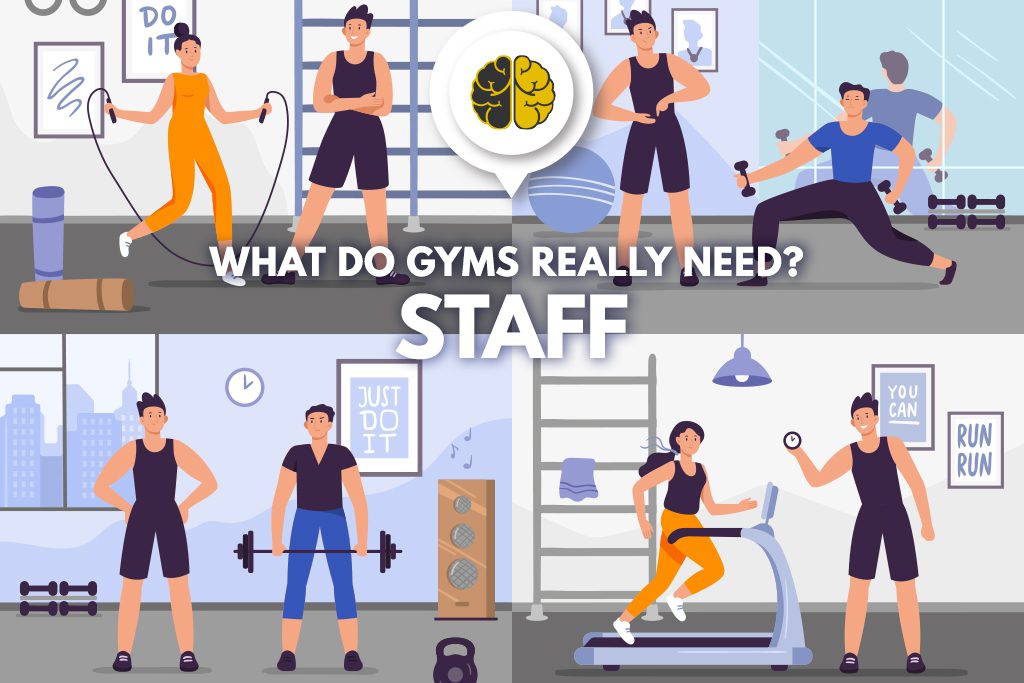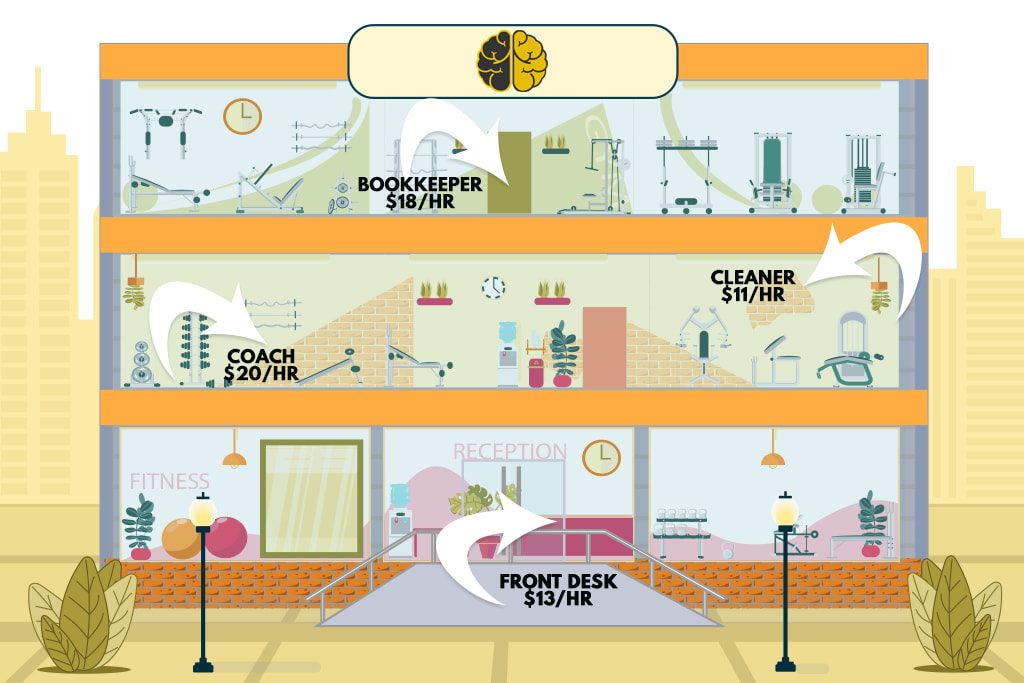Pop quiz: When you reach 50 clients in your gym, who’s the first person you hire?
If you said, “Another coach!” you’re wrong. But almost 100 percent of us would have answered the same.
The truth is that most gym owners need help—but not coaching help. They need help doing the stuff they hate (admin, bookkeeping, cleaning, sales, marketing, management), but they only know how to identify good coaches, so they hire coaches. And then they wind up with a choice: They can spend all day doing stuff they hate or they can micromanage the other coach. Neither option is a win!
Your role as entrepreneur is to invest your time in the highest-value roles. That means removing less-valuable things from your plate. But most entrepreneurs don’t do this well.
They say things like:
“No one can do this like me!”
“It’s faster to just do this myself!”
“I can’t afford any screwups!”
“No one cares as much as I do!
And the biggest one of all: “I just love coaching! I don’t want to give it up!”
Hey—I know that one, because that’s me. Most days, I don’t want to be the CEO; I just want to coach people. So here’s what I’d do in your shoes (because I wear the same ones).
1. Break down your day by the hats you wear.
If you were to duplicate yourself into 12 clones and each clone could only do one job all day, what would those jobs be?
Coach? Scheduler? Workout programmer? Cleaner? Bookkeeper? Cashier? Graphic designer? Email writer? Funnel builder?
Make a list. We call these “roles.”
2. Now program your clones: Make a step-by-step list of everything you do in each role.
For example, the cashier is responsible for entering client sales correctly, processing refunds, collecting money, closing the batch at the end of the night, balancing receipts with collected funds at the end of the shift (and end of day), depositing funds at the bank, and so on.
Make the checklist as simple as possible. We call these “tasks.”
3. Assign an hourly value to each role. What would it cost to replace yourself?
- Cashier—$13 per hour?
- Programmer—$18 per hour?
- Coach—$20 per hour?
- Cleaner—$11 per hour?
We call these costs “replacement value.” You will hire valuable people to replace you in each role eventually. And you will pay them what the role is worth.
4. Next, do a Time Valuation on yourself.
How much time do you spend in each Role? Record your total time spent (in hours) for one week.
For example:
- Cashier—10 hours
- Coach—20 hours
- Programmer—3 hours
- Cleaner—5 hours
Multiply total time by the replacement value of each role.
- Cashier—10 hours x $13 per hour = $130 replacement value
- Coach—20 hours x $20 per hour = $400 replacement value
- Cleaner—5 hours x $11 per hour = $55 replacement value
5. From your list of replacement values, find the lowest. Hire a person to fill that role.
Give the person a three-month contract that clearly spells out the role and every associated task.
In other words, provide a checklist.
6. Here’s the critical part: You, the owner, must reinvest the time you save by working in a higher-value role.
We call this “climbing the value ladder.”
If you bought yourself five hours by hiring a cleaner, you must show a positive return on that purchase.
You can either replace the cleaner for five hours, saving yourself $55 (five hours x $11) or you can jump a few rungs up the ladder and spend time in a new role, like marketing.
7. After a month, evaluate your staff’s performance.
Assign a scale from 1 to 10 for each task.
Review performance with the staff member. What can he or she improve?
Now review your performance in your new role. What can you improve Are you seeing a positive return?
8. After three months, repeat steps 5, 6 and 7.
Buy yourself more time. Climb to the next step. Measure your ROI.
Building a Real Business
Most entrepreneurs never build a business: They buy themselves a job instead.
But if they want to scale, be able to sell their business someday or just take a holiday, they must replace themselves in all roles eventually.
This is the directive approach we teach entrepreneurs in the Two-Brain Business Mentorship program. It’s virtually risk-free and far less scary than the usual “ready, fire, aim” approach to hiring.
Do you need coaches? Probably. As you scale up, you will need some help. Not 10, but maybe two. They don’t necessarily have to be full time, either. Read: “Gym Management: The Case for Part-Time Coaches.”
If you want a career as a coach, you can have one. Replace yourself in all other roles and coach people.
If you want a career as CEO, you can have that, too: Replace yourself as coach and level up the business. Read “How to Hire Coaches Without Hurting Yourself.”
How to Fix It: Staffing
COVID had a forcing function on staff. When pressure was applied, some staff said, “I didn’t sign up for this.” And often, those were the staff people who didn’t really align with the gym owner’s vision anyway. Phew!
But in other cases, gym owners have had to make very hard decisions about paying their family or paying their staff. And even when a staff person should go, a tough conversation is often required.
Step 1: Mentally Fire Everyone
First, we’re going to start from a blank slate. We’re going to “fire” everyone mentally and then “re-hire” those who fit.
Follow the plan above. This time, instead of tailoring a role to fit the person, ask yourself, “Can this person fit this role?”
Fill the jobs that need doing instead of filling a person with jobs. (You can still be a friend.)
Step 2: Rehire
Second: Re-hire the obvious candidates for the new roles. Note: Exceptional delivery of their past roles might not actually qualify them for the new ones.
If someone does really well at maintaining positive coaching over text, great—they have a spot in your new business.
If someone can run a group group class over video with maximum engagement, great—you have a place for them.
But if someone is a highly credentialed weightlifting coach, you might not.
Starting an online training business isn’t like starting a location for your gym. It’s more like starting a barbershop. If you have an online component in your gym now, hire for that role instead of trying to squeeze an existing person into a spot they don’t fit.
Step 3: Consult and Remove
Third, remove the easy non-candidates for your new business.
The most important question you can ask your staff is this: “What do you want now?”
Some of your staff might not want to be part of the next phase. Let’s remove those folks from the equation first.
Pick up the phone and say, “We have a new business now. Do you want to be part of it?” and let them make it easy for you.
Step 4: Clean House
Fourth, remove the rest of them.
Don’t give people a job just for the sake of giving them a job.
I’m so guilty of this one that it took me a minute to write the sentence above. But as my mentor Marcy told me:
“You think you’re being tactful. You think you’re giving them every chance to succeed. But sometimes, you’re just hiding.”
Logically, I know this: Their lack of performance isn’t my fault. But it is my responsibility.
So here’s the trick I use: the hierarchy of responsibility.
- My family.
- My clients.
- My staff.
(I could put “you” at the top because you’re actually most important. If you go down, your family suffers. But let’s face it: Any time I tell gym owners to put themselves first, they don’t listen. I don’t either. So I’ll save you that lecture.)
Your business exists to serve your family.
You recruited your clients to pay your business.
You recruited your staff to serve your clients.
And you build an audience of new clients to serve your staff.
Never sacrifice your family to pay your staff.
Never sacrifice your paying clients for your current clients.
You get it.
Now, here’s the mental trick I use to take hard action with staff: If a staff person isn’t doing well, then it affects my clients and my family. I ask myself, “Am I willing to do this hard thing to benefit my clients?”
Almost every time, the answer is “yes.” The only time I say “no” is when I can move the staff person to a non-client-facing role.
Then I ask myself, “Am I willing to do this hard thing to benefit my family?”
The answer to that one is always yes.
So when a staff person isn’t serving my clients as well as he or she could, I totally dread the conversation. But ultimately I ask myself, “Do I care enough about my clients to do this hard thing for them?”
And the answer is always yes.
If I asked myself, “Do I care enough about my own health and stress and happiness to do this hard thing?” I’m not sure I’d always say yes. I tend toward self-martyrdom (or hiding, as Marcy says).
There are other things you’ll have to think about—including legal considerations. But just remember: Conversations usually solve everything. Don’t be afraid to have them.
More than ever, it’s critical to surround yourself with the right people. Not every staff person is going to take this next step with you. But the best ones—the few and the proud—will actually pull you forward when you need it.
Other Media in This Series
“What Do Gyms Really Need?”
“What Do Gyms Really Need?—Space and Equipment”
“What Do Gyms Really Need?—Services and Schedules”


